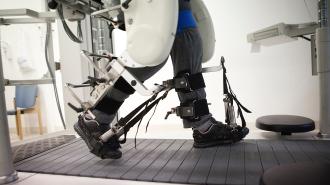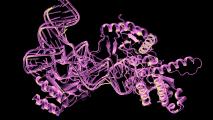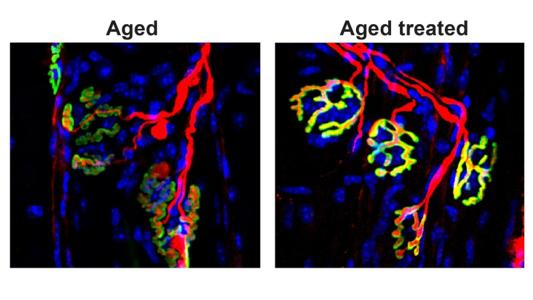A hydrogel containing gold nanoparticles could one day be combined with electrical stimulation to help people regenerate after major muscle injuries.
The challenge: If you lose a bit of muscle due to a prolonged illness or simply slacking on exercise, getting it back is generally pretty straightforward: just start hitting the weights, and you’ll be your buff self again eventually.
Volumetric muscle loss is a different beast. When you lose a whole chunk of your skeletal muscle — usually due to something traumatic, like a car accident or a battlefield injury — the affected limb won’t work like it used to.
Recovering function after such an injury often means extensive rehab. For a leg injury, for example, you might spend hours walking on a treadmill, perhaps wearing a robotic exoskeleton that helps you move your leg.
“We’ve created an injectable, mechanically tough, and electrically conductive soft tissue prosthesis.”
Shin Mikyung
This might strengthen your remaining muscles enough so that you can walk again, but it doesn’t actually help your body recover a substantial amount of the lost muscle and nerve.
Electrical stimulation can also help regenerate lost muscle tissue, but the devices used to deliver that stimulation can be inflexible and hard to position right at the site of the injury.
What’s new? Researchers at the Institute of Basic Science (IBS) in South Korea have now developed an electrically conductive hydrogel that can be injected directly into the place where you need to regenerate muscle.
It helps the body regrow the missing muscle, while also allowing doctors to apply electrical stimulation right where it’s needed. The hydrogel then dissolves on its own — no need for surgery to remove it.
“We’ve created an injectable, mechanically tough, and electrically conductive soft tissue prosthesis ideal for addressing severe muscle damage requiring neuromusculoskeletal rehabilitation,” said researcher Shin Mikyung.
How it works: The basis of the hydrogel is hyaluronic acid, a slippery substance found naturally throughout the body and known to promote tissue regeneration. By adding gold nanoparticles to this substance, the researchers made it electrically conductive.
They then tweaked the chemistry of the hydrogel so that bonds in it would break under force but then reassemble. This meant it would flow easily through a needle when pressured by a syringe, but then become stiff enough to stay in place in the muscle cavity.

To demonstrate how the hydrogel could help repair muscle injuries, the researchers removed a chunk of muscle from the back legs of rats. They then injected their hydrogel into some of the rats and left some untreated.
Three days later, they put the rats on a treadmill and used wires to connect a nerve in their leg above the site of the injury to a robot system.
This system could receive electrical signals from the nerve through the wires. This let it know exactly when the animal was trying to contract its muscles to lift its foot — a robot could then physically help with the movement, just like an exoskeleton.
The system could also send signals through the wires to the nerve, electrically stimulating the muscle. Because the hydrogel was electrically conductive, these signals could reach the other side of the gap, helping the rat lift its foot.
Compared to untreated injured mice, the treated animals were able to walk sooner and had accelerated muscle regeneration.
“The fact that the gel could … help the animal move the leg only three days after injury was really important.”
Milica Radisic
Looking ahead: While the results of the study are promising, rats’ muscles are tiny compared to people, meaning we don’t know if the hydrogel works as well at repairing large injuries in humans — studies in larger animals will help shed light on that.
The use of wires to connect the animals to the robot is also less-than-ideal — Mikyung said the team would be exploring ways to deliver the stimulation without those.
The big picture: If the hydrogel is able to make its way through the development process and into the clinic, it could have a huge impact on people trying to recover from serious muscle injuries.
“The fact that the gel could propagate electrical impulses to help the animal move the leg only three days after injury was really important because it shows that this approach — the hydrogel together with electrical stimulation — restores the function,” Milica Radisic, who wrote an expert analysis on the paper, told the Nature Podcast.
“For injured humans, that’s the most important thing … The sooner they can regain this walking function improves the quality of life, but also perhaps it minimizes the detrimental effect of the injury because it breaks that cycle of use it or lose it,” she added.
We’d love to hear from you! If you have a comment about this article or if you have a tip for a future Freethink story, please email us at [email protected].






